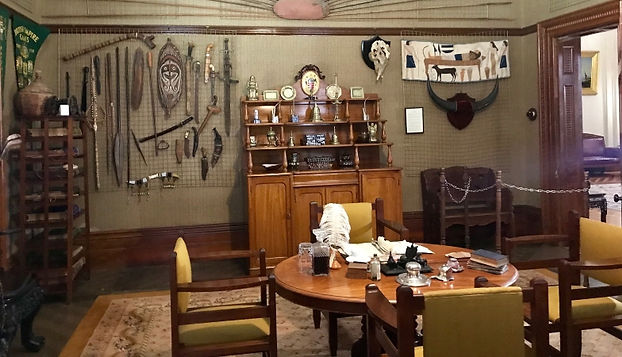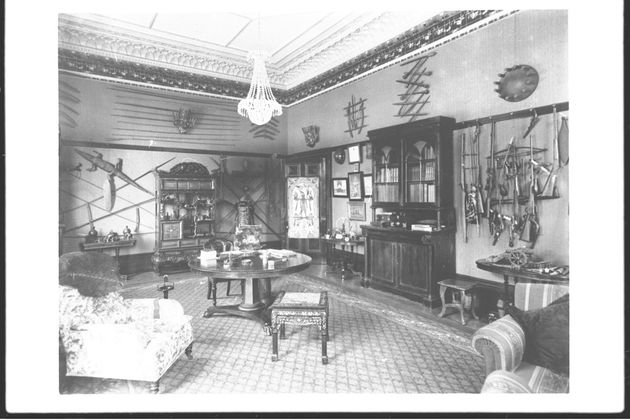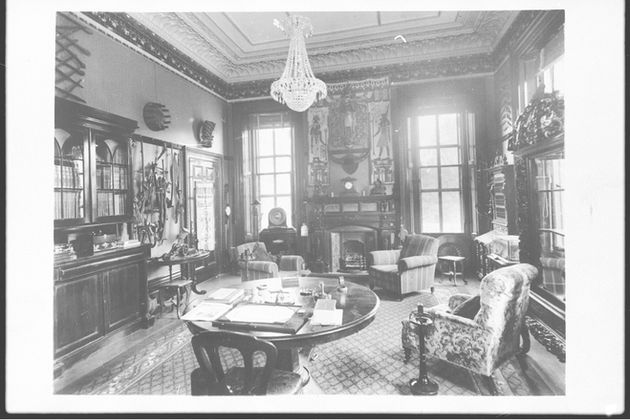
Open Sundays/Public Holidays 10.00 am to 3.00 pm

Martindale Hall Story: 4
The Mortlocks purchase
Previous page: The Bowmans of Martindale Hall
The Martindale Hall Story
-
In The Beginning - the Bowman Family Arrives in Australia.
1a: Chronology of Martindale Hall -
Edmund Bowman (senior) - Notes from the book "The Bowmans of Martindale Hall"
-
The Bowmans of Martindale Hall
3a The Martindale Mansion
3b Martindale Sports -
The Mortlocks of Martindale Hall
4a Martindale House
4b MV Yacht Martindale

...A double wedding of such social importance was calculated to create the greatest interest, especially amongst the ladies, and long before the appointed time for the ceremony, the church was crowded....
The Mortlocks of Martindale Hall
A double wedding that was almost too much for Adelaide to absorb...
At St. Peters, Glenelg, on 28 January 1891, Rosye Tennant married William. T. Mortlock, the well-known pastoralist,
while her sister married Capt. Anstruther Thompson, who afterwards assumed the name of Gray on coming into some property (see below).
At the time of his wedding he was A.D.C. to Lord Kintore, then Governor of South Australia.
Rosye was the older sister of Mrs. R. M. Hawker, formerly Adelaide Tennant, the youngest daughter of Andrew Tennant, and for many years chatelaine of Bungaree homestead.
Below: The Ship Imaum of Muscat in 1836, a gift to King William IV
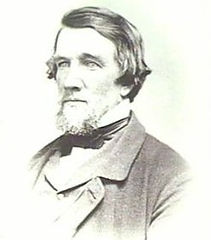
Above: William Ranson Mortlock
Birth
1821
Melbourn, Cambridgeshire, England
Death
10 May 1884
Medindie, Adelaide, South Australia, Australia
Cultural Heritage
Occupation
Biography (Aust. Dict. Biog.)
William Ranson Mortlock M.P., father of the Groom
W. Ranson Mortlock (illustrated at left) was born in about 1821 at Moat House, Melbourn, Cambridgeshire, England, the son of William Mortlock and his wife Mary (née Newling).
-
In 1843 William emigrated to South Australia on the ship Imaum of Muscat (illustrated above).
-
During the crossing-the-line equatorial ceremonies he was thrown overboard wearing a heavy money-belt and had to struggle hard to regain the ship.
-
His family was deeply involved in banking.
-
William Ranson Mortlock was just twenty-two years old when he settled in Adelaide in 1844 to run the Globe Hotel.
This was a time of severe depression in the colony but Mortlock was equipped with both capital and business skills.
-
During his first year in Australia, he journeyed to New South Wales to survey prospects before deciding to settle in South Australia, where he initially set up as a maltster.
-
With as much commercial commonsense as vision, Mortlock invested in the pastoral industry and
-
in 1847 Mortlock took up the Yalluna run near Tumby Bay, put 5,000 sheep on it and found a suitable manager.
-
At the same time he operated two flour mills, one at Noarlunga and the other in Halifax Street, Adelaide, each of them able to serve prime farming districts.
Both his milling and sheep farming were very profitable.
He built up four grazing runs on the lower Eyre Peninsula:
-
Yalluna: His first venture was near Port Lincoln; with additional leases and purchases it became Yalluna station.
-
Strawberry Hill: H.C. Talbot says this station received its name from the simple fact that a bullock bearing the appetising name of "Strawberry'' was lost... his carcass was found on the hill.
-
Coffin's Bay at the southern extremity of the Eyre Peninsula, a wheat growing area
-
Lake Wangarey surrounding the freshwater Lake Wangary.
In the north of South Australia, William Mortlock acquired three large stations:
-
Mount Arden, on an arid plain between the Flinders Ranges and the highway and south of Lake Torrens, with natural springs
-
Angorigina east of Blinman mine, and
-
Yudnapinna, where 100,000 sheep were handled at one shearing.
Marriage of W. Ranson Mortlock
On 10th May 1850 William Ranson Mortlock married Margaret Tennant at Port Lincoln and they had a family of six children, including William Tennant Mortlock who was later to own Martindale Hall, near Mintaro in the mid-north.
-
When the Halifax Street mill was destroyed by fire in 1857, Mortlock abandoned that business and settled on Eyre Peninsula.
-
His pastoral investments expanded further into property on the Peninsula and also, in 1867-68, into the northern areas of the state, at Mount Arden, Angorichina and Yudnapinna.
-
The latter station alone stocked 100,000 sheep.
Mortlock had the ability to select good overseers for his properties and his own commercial expertise assisted in his pastoral success.
-
He held directorships of a number of companies and amassed a considerable fortune.
-
In August 1858 a parcel of land he sold to John Harvey, a farmer at Tumby Bay, became the first piece of real estate registered under the Torrens Title system after the Real Property Act came into force.
-
Mortlock had another significant interest, horse racing, and he always kept a number of horses in training.
-
He was an enthusiastic fisherman, and had at Coffins Bay two motor launches and the yacht Whynot. He entertained large parties of sportsmen during the Christmas holidays.
-
He had a stud flock of Merinos and won many prizes at country shows.
He was noted for his liberal views and in 1868 he won the seat of Flinders in the House of Assembly, holding it, apart from a break during a trip to England, until 1884.
Aged 63 he died at Avenel House, Medindie, on 10 May 1884, survived by his wife, one son: Mr. William Tennant Mortlock, and three married daughters,
Mrs. E. H. Spicer, Mrs. E. C. Gwynne, and Mrs. J. T. Toll..
His probate was sworn at nearly £100,000.
-- Obituary
-
His son William Tennant Mortlock (1858-1913) was educated at the Collegiate School of St Peter, Adelaide, and Jesus College, Cambridge. He joined his father's interests and succeeded to his estates. (See Below)
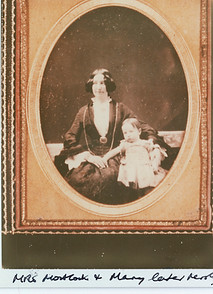
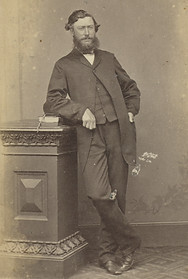
Above: Andrew Tennant
Andrew Tennant M.P., father of the brides
Andrew Tennant (1835-1913), pastoralist and politician, was born on 20 June 1835 at Hawick, Roxburghshire, Scotland, son of John Tennant, shepherd, and his wife Jessie Aitken;
-
as an assisted migrant John brought his family to South Australia in the Duchess of Northumberland on 19 December 1839;
-
John Tennant in 1845 and 1846 overlanded a large flock of sheep for the first time from Adelaide around the head of Spencer Gulf and into the Port Lincoln district. He later bought Tallala station. A cairn is built there as a memorial.
-
Tennant Creek, Northern Territory, is named after him.
Business Interests
Aged 18, Andrew took cattle west to the shores of Lake Newland near Elliston, and settled at Salt Creek. The holding had been abandoned because of the Aboriginals' hostility, but Tennant was unafraid and for seven years he controlled the natives while successfully managing his sheep and cattle station.
-
Later Tennant owned stations at Mount Wedge, Coffin's Bay and Streaky Bay.
-
In 1886 he leased the large block, Baroota near Port Germein, but owing to severe droughts had to move,
-
subsequently acquiring from Sir Thomas Elder the Oorama and Baratta runs.
-
-
He remained there for a year or two, then sold the properties and purchased
-
Willipia station in the same neighbourhood,
-
Moolooloo (1800 sq. miles) (4662 km²),
-
Murapatina near Mannahill (1500) (3885 km²), and
-
Undoolya station near Alice Springs (10,000) (25,900 km²).
-
Later he established Yardea station and owned and worked Corraburra near Port Augusta until his death.
Other runs held by him included
-
Portee near Blanchetown,
-
Princess Royal near Burra, and
-
Middle Back near Whyalla, now handed over to the Australian Defence Force as part of the Cultana army base expansion.
In addition he owned 13,000 acres (5261 ha) at the Hermitage near Riverton, much valuable freehold property in the city of Adelaide and held stations in New Zealand.
Tennant had large interests in the Seaham and Abermain Colliery companies in New South Wales and
-
he was the principal shareholder in the Tarcoola Blocks Gold Mine, a venture in which he lost heavily.
-
He was a director of the China Traders Co. and of the Adelaide Steamship Co. Ltd from its inception.
-
A justice of the peace, he was for many years a Freemason under the Grand constitution.
-
A generous patron of the turf and lover of thoroughbreds, Tennant established a stud at Hermitage and successfully raced horses throughout South Australia. For many years president of the Port Augusta and Flinders Jockey Club, he was closely associated with all metropolitan and a number of country racing clubs.
In 1881-1887 Tennant represented Flinders in the House of Assembly in South Australia.
-
In 1898-1902 he sat in the Legislative Council for the Northern District.
-
He was a member of the Pastoral Lands Commission in 1897-98.
Andrew Tennnnt was one of the most successful pastoralists of South Australia, and also was one who had done a great deal to advance the pastoral industry of South Australia.
Obituary: Chronicle (Adelaide, SA) Sat 26 Jul 1913 Page 44
Marriage of Andrew Tennant
On 28 August 1862 in Adelaide he married Rachael Christina Ferguson.
-
They lived at Tallala Station near Port Lincoln, later at "Essenside", Glenelg.
-
Andrew Tennant died on Saturday, July 19, 1913, at 'Essenside', Moseley Street, Glenelg.
-
Mrs Andrew Tennant died in 1921 at the age of 80 years. she had resided at Glenelg more than 40 years. Mrs Tennant took an active interest in philanthropic movements.
-
-
He was survived by his wife, three daughters and three of his four sons,
-
He died of diabetes and senile dementia in his home, "Essenside", Moseley Street, Glenelg, (illustrated below) on 19 July 1913, and was buried in the Brighton cemetery.
-
His South Australian estate was sworn for probate at £506,248.
Family of Andrew Tennant
-
John Tennant (1864 – 26 May 1941)
married (cousin?) Margaret Barr Love, (illustrated left with child Andrew)
( – 19 May 1954) on 10 August 1898, lived at Princess Royal Station c. 1906-
Andrew Tennant (c. 1899–1974) married Gwendoline Letitia "Gwen" Goodman (1905–1998) on 11 October 1928.
Gwen was a daughter of Sir William Goodman.
Both were interred at the North Road cemetery. -
Joan Royal Tennant (1906– ) married Brian Herbert Swift in 1934
-
-
Rosina Forsayth "Rosie" Tennant (c. 1867 - 1939)
married cousin William Tennant Mortlock (1858 - 1913) on 28 January 1891
(a double wedding).-
He was son of Margaret Tennant and William Ranson Mortlock, (see above)
-
-
William Andrew Tennant (1868 – 20 February 1929) of Point Lowly Station, Port Augusta West, married Elizabeth Mary Meincke (1900) and
Matilda Elsie Audacia Hobbs née Polkinghorne (1925) -
Jessie Clara "Clayre" Tennant (1872–1958)
married William Anstruther-Thomson (1860– ) on 28 January 1891
(a double wedding). F.R.G.S., who adopted the name of Gray on succeeding to the Carntyne Estate in 1904. He was aide-de-camp from 1889 to 1891, during Lord Kintore's term as Governor of South Australia. -
Frederick Augustus Tennant (22 July 1874 – 1937) solicitor, of Adelaide,
married Kathleen Hammill ( – ) on 28 October 1914, moved to Melbourne -
Adelaide Tennant (22 July 1874 – 8 April 1952)
married Richard McDonnell Hawker (1866 – 24 March 1930), son of G. C. Hawker on 25 February 1903
Below: "Essenside", aka 'Essendene', Mosely Street, Glenelg, the home of Hon, Andrew Tennant
Essenside was built as a seaside home for Capt. Edward “Ned” Bagot,
his wife Anne (nee Smith) and their children.

Birth
20 June 1835
Hawick, Roxburghshire, Scotland
Death
19 July 1913
Glenelg, Adelaide, South Australia, Australia
Cause of Death
Cultural Heritage
Education
Occupation
Key Organisations
Properties


William Tennant Mortlock (a groom)
William Tennant Mortlock (1858 – 17 August 1913) was a South Australian grazier and politician.
-
Mortlock was born near Port Lincoln, the eldest son of William Ranson Mortlock.
-
William Tennant Mortlock (illustrated as a baby in a well-known daguerreotype at left, with nurse Jemima Gunlarnman) was educated at the Collegiate School of St Peter, Adelaide, and Jesus College, Cambridge. (Baby William wriggled while exposure in progress, and his face has blurred.)
-
Though admitted to the Inner Temple on 24 October 1878 he did not practise in South Australia but joined his father and succeeded to his estates.
-
He worked on his father's Yudnapinna Station, near Port Augusta
-
He inherited the family's pastoral property upon his father's death in 1884.
-
William represented the seat of Flinders in the House of Assembly in 1896-99 and 1901-02.

.jpg)
Above: William Tennant Mortlock (1858-1913)
Below: Rosye F. Mortlock

-
In 1891 he purchased Martindale Hall at Mintaro, which would become his family's main station.
-
Martindale Hall is a Georgian-style mansion built in 1879-80 near Mintaro, where he continued the hospitality established by its previous owner, Edmund Bowman, attended to his fine merino flock, developed the gardens and orchards and pursued his racing interests.
-
Mr. S. Scott, was manager of Martindale for the late Mr. W. T. Mortlock lor 13 years and resided part-of that time at the hall.
Advertiser (Adelaide, SA), Monday 18 August 1913, page 14
Mr. Mortlock was a valuable assistant to his father, after whose death he increased the pastoral properties possessed by the Mortlock family.
An idea of the size of the territory he controlled can be obtained when it is stated that
-
Yudnapinnie, Mount Arden, and Euro Bluff stations together represent 1,600 square miles;
-
Coffins Bay, 200 square miles;
-
Angoritchna, 100 square miles;
-
Yalluna and Strawberry Hill, 13,000 acres;
-
Martindale Hall, 10,000 acres; and
-
Warratta Vale (purchased in 1897), 36,000 acres.
The work of superintending operations over such an immense area made his life a particularly busy one.
However, he managed to find time for public duties, and he was elected to the House of Assembly for Flinders on April 25, 1896.
In the House Mr. Mortlock acquitted him-self creditably, his intimate knowledge of the country being of value in legislative matters connected with pastoral affairs.
Mr. Mortlock was a true sportsman, and there is hardly a racing club of any importance in the State with which he was not associated.
-
Of the Port Augusta Racing Club he was a leading member and office-bearer.
Some time ago Angoritchna and Strawberry Hill stations were sold.
At the present time a scheme is under consideration for the subdivision of 300 acres of land known as Grange Farm.
Mr. Mortlock bred and raced Yudnapinna in the Grand National of 1911 when he beat Destinist.
-
He had a stud flock of Merinos and won many prizes at country shows.
-
He was an enthusiastic fisherman, and had at Coffins Bay two motor launches and the yacht Whynot.
-
He entertained large parties of sportsmen during the Christmas holidays.
The Double Wedding
William Mortlock married Rosina Forsyth Tennant on 28 January 1891 at St. Peter's Church, Glenelg
in a double-wedding with her sister, Clayre Jessie Tennant,
who married Capt. Anstruther Thompson (the other groom);
-
Clayre Jessie Tennant, born on 30th August 1872 in Port Lincoln, South Australia, was the 2nd daughter of Andrew Tennant.
-
Clayre became engaged to William Anstruther-Thomson, Aide de Camp to the Governor of South Australia, on 6th January 1891.
-
They married, in a double wedding ceremony with Clayre's elder sister Rosina Forsyth Tennant, at St Peter's Church, Glenelg, South Australia.
-
These newly-weds sailed to the UK the following day.
-
-
When William Anstruther-Thomson (illustrated left) succeeded to the Carntyne estate in 1904, he adopted the surname Gray. This was (retrospectively) incorporated into Clayre's name and also their three children:
1. Ruth Mary St Clair Anstruther-Gray
2. Jean Helen St Clair Anstruther-Gray
3. William John St Clair Anstruther-Gray
-
Clayre became a Justice of the Peace and was invested Commander, Order of the British Empire (C.B.E.) in 1934.
-
She died on 22nd October 1958 in Kilmany Parish District, Fife, Scotland, aged 86.
-
-
both were daughters of Andrew Tennant.
-
Rosina and William were cousins, as Andrew Tennant was a brother of William's mother Margaret.


Quiz and the Lantern (Adelaide, SA), Friday 30 January 1891, page 8
THE FASHIONABLE WEDDINGS.
"St. Peters Church, Glenelg, was on Wednesday afternoon the scene of two of the most fashionable weddings of the season. The participants in the ceremony were
-
Captain Anstruther Thomson, A.D.C. to His Excellency the Governor (Lord Kintore, illustrated below),
-
and Miss Clayre Tennant,
-
and Mr. Tennant Mortlock, son of the late Mr. W. R. Mortlock, M.P., and
-
Miss Rosa Tennant,
the ladies being the daughters of Mr. Andrew Tennant, a sheep farmer of extensive operations in South Australia, and the holder of large squatting properties in New Zealand.
As was to be expected, a double wedding of such social importance was calculated to create the greatest interest, especially amongst the ladies, and long before the appointed time for the ceremony, the church was crowded by a fashionable assemblage of sight-seers."
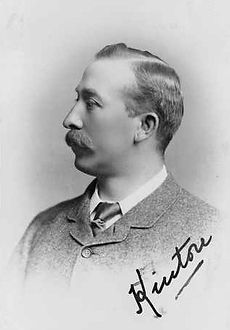
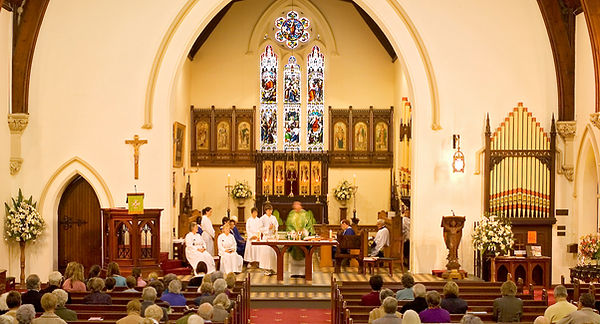

Below: Mr Andrew Tennant, c1900

The interior of the [church] building was beautifully decorated, and a special choir was in attendance.
-
As early as half-past 12 o'clock a very large crowd had gathered at the church doors waiting for admission, including ladies from almost every suburb round the city.
-
The church was crowded to excess, numbers of late arrivals being quite unable to gain admission.
"At about five minutes to 2 o'clock (the hour fixed for the wedding) the bridegrooms arrived, attended by their groomsmen.
-
Captain Thomson (illustrated above, on "Rainbow") and Major Gordon were attired in their brilliant undress uniforms, the gold lace and coloring of which served to show off the exquisite dresses of the bridal party.
-
Captain Anstruther Thomson was attended by Mr. Colin Campbell (Private Secretary to Lord Kintore),
-
and Mr. W. Tennant Mortlock by Major Gordon (illustrated left)."
"The church was most artistically decorated with arches of evergreens, white flowers, and pot plants.
-
The service was full choral, and was performed by the Rev. B. G. Stephenson, Bishop's Chaplain, Mr. Harold Davies officiating at the organ.
-
Punctually at 2 o'clock the bridal party arrived and proceeded up the aisle in the following order: —
-
Mr. and Mrs. Andrew Tennant walked first,
-
followed by the two brides,
-
they in turn being followed by their 8 bridesmaids.
-
Arrived at the altar the father of the brides took up his position in the centre with a bride, bridegroom, and four bridesmaids on either side of him."
-
The bridal gowns were beautifully made, the material being a rich brocaded satin.
-
The skirts were characterised by artistic simplicity, the hem in front being bordered with a thick ruche of plain soie Francaise.
-
They were both made with very long Court trains, high sleeves, and Medici collars, with a full ruche of the satin falling over the feet. The bodices were close fitting and quite plain.
-
A very long tulle veil completely covered the train. Sprays of orange blossom in the neck and hair, white satin shoes, and most beautiful bouquets of white flowers tied with wide white ribbons completed two of the most elegant bridal costumes ever worn in the colony.
-
- Miss Tennant was attended by Miss Ferguson (chief bridesmaid) and the Misses Love.
- Miss Clayre Tennant had her sister (Miss Adelaide Tennant) as chief bridesmaid; and
- Misses Bessie and Belle Macfarlane and Miss Murray.
Read much more: Quiz and the Lantern (Adelaide, SA), Friday 30 Jan. 1891, page 8 FASHIONABLE WEDDINGS.
On the morning of the wedding Mr. Andrew Tennant, the father of the brides, handed over to the two gentlemen, whom he has appointed trustees, deeds representing a gift of £20,000 to each of his daughters.
The Family of the Mortlocks
Their children were:
-
William Ranson Mortlock (1891-1892) Born Nov 1891. Died on 16 July 1892, aged 8½ months, at Essenside.
-
John Andrew Tennant Mortlock (1894-1950) was his eldest surviving son
-
Frederick Ranson Mortlock (1900- 5 Aug 1936) - never married, died in Colombo, was drunk when he fell off a boat in Colombo Harbour.
"A nice young man with winning ways, good looks, high wealth", loved sports, raced horses, and loved drinking. -
Their mother indulged both of them dreadfully; they were incredibly spoilt and, like many others with “new” money, wasted huge amounts on their cars, race horses, yachts , booze and other frivolities.
-
Joan Royal Tennant (1906– ) married Brian Herbert Swift in 1934.
William died (young) in a private hospital in North Adelaide in 1913, aged 55, following a six-month illness. He was interred in the Mortlock family vault at the North Road Cemetery
The Mortlock Weapons Collection
The Mortlock Weapons Collection (pictured below) is intrinsically related to the ‘baronial’ lifestyle achieved at Martindale Hall by the Mortlock family.
The weapons were collected in the late nineteenth and first half of the twentieth centuries by William Tennant Mortlock and then his son John Mortlock (Jack), during their travels around Australia and overseas.
The collection was prominently displayed by the Mortlocks in the Smoking Room at Martindale Hall, and illustrates a way of life that no longer exists in South Australia.
Summary of State Heritage Object: 10067-001
Mortlock Weapons Collection Object intrinsically related to Martindale Hall (10067)
A pictorial feature on Martindale Hall that appeared in the March 1932 edition of the popular monthly magazine South Australian Homes and Gardens included two images of the Smoking Room and a brief text caption.
The images illustrate the extensive nature of the collection at that time and make particular note of the Japanese or Samurai suit of armour and other weapons within the room.
Two images of the Smoking Room taken by HDC Collyer in 1936 and now in the pictorial collection of the State Library of South Australia show the room configured in a very similar manner to the 1932 images
The Advertiser also ran a feature on Martindale Hall in 1937 noting that the contents of the Smoking Room were ‘gathered from all ports of the world’iv and included armour and weapons displayed on the walls.
In October 1948, the Pioneer’s Association of South Australia toured Martindale Hall and shortly after published a small booklet authored by a number of association members recounting their experiences of the Hall and its contents.
News (Adelaide, SA), Friday 18 August 1939, page 1
£18,565 IN BEQUESTS UNDER WILL
Mrs. Mortlock's Big Legacies
Legacies and bequests totalling £18,565 have been left under the will of Mrs. R. F. Mortlock to charitable and other institutions in Adelaide.
Mrs. Mortlock, who died last Saturday, had always been a generous supporter of charities, to which she gave considerable sums every year.
The will provides for the appropriation and investment by the trustees of the undermentioned funds:—
-
A fund of £10,000, to be known as the Rosye Mortlock Charitable Bequest, the income of which is to be divided between charitable institutions
-
conducted under the auspices of or in connection with the Church of England in South Australia,
-
having for their objective charitable purposes as prescribed by the will.
-
A fund of £5,000, the income of which is to be paid to and devoted by the University of Adelaide for cancer research.
-
Two funds each of £1,000, the income of which is to be paid to the wardens of St. Margaret's Anglican Church, Tumby Bay,
-
and St. Peter's Anglican Church, Mintaro, and devoted by them to the general purposes of the church.
Other legacies are:
-
Adelaide Children's Hospital, £815 for the endowment of one ordinary cot and one baby's cot, each to be known as The Rosye Mortlock Cot.
-
Church of England Boys' Home, Walkerville, £250.
-
Orphan Home, Adelaide, £250.
-
Adelaide Benevolent, and Strangers' Friend Society, £250.
-
All the above benefits are conferred free from payment of duties.
Was 48 Years at Mintaro
Before her death Mrs. Mortlock contributed £25,000 — shared equally with her son, Mr. J. T. Mortlock —
-
to the Adelaide University for research work in soil erosion and the regeneration of pasture lands, in memory of her younger son, Mr. F. R. Mortlock.
-
The terms of this benefaction included the construction of a laboratory at the Waite Agricultural Research Institute which is known as the Ranson Mortlock Laboratory.
Mrs. Mortlock was the widow of William Tennant Mortlock, of Martindale Hall, Mintaro, and a daughter of Mr. and Mrs. Andrew Tennant, of Glenelg.
Mrs. Mortlock's bequests to St. Margaret's Anglican Church, Tumby Bay, and St. Peter's Anglican Church at Mintaro, recall her 48 years of residence at Mintaro and the pioneering of Tumby Bay by her grandparents.
Elder's Trustee & Executor Co., Ltd., and Mr. E. E. Scarfe are named as executors and trustees in the will.
The lay superintendent at the Children's Hospital (Mr. Smith) said that the legacy was highly appreciated. The hospital considered that the idea of endowing cots was one of the best living memorials one could possibly have.
Mrs. Mortlock had been a subscriber to the hospital for many years, and had been interested in the work there. The Rev. Harold Giles, of Marryatville, who was associated with the Church of England at Auburn several years ago, said that Mrs. Mortlock had always been a generous supporter of the local church.
Her gift to the church, and the establishment of the fund for assistance to charitable institutions was a praiseworthy gesture.
Ranson Mortlock Scholarships
Applications open 9am, Friday 15 January 2021
Applications close 5pm, Friday 26 February 2021
Payment per year $10,000 Duration 1 year
Program - Honours program relevant to soil erosion and regeneration of pastoral land
Degree - Honours
The Ranson Mortlock Trust was established in 1936 following a donation from the Ranson Mortlock family in memory of the late Mr Frederick Ranson Mortlock.
The Ranson Mortlock Scholarships will support up to two undergraduate students who are undertaking Honours projects relevant to soil erosion and the regeneration of pastures on pastoral land at the University of Adelaide.


John Andrew Tennant Mortlock ('Jack', son & heir)
Mr John Andrew Tennant Mortlock (1894-1950) was the eldest surviving son of William and Rosin ('Rosye') Tennant Mortlock.
-
his residence at Mintaro near Clare was Martindale Hall. made famous through the movie Picnic at Hanging Rock.
-
He was educated at F. I. Caterer's Glenelg Grammar School then followed his father as a student at St Peter's College in South Australia, and at Jesus College, Cambridge University.
-
In 1913, on receiving news of his fathers death, he left without graduating and took charge of the family properties, which included Martindale Estate and Martindale Hall, as well as cattle and sheep stations and other properties in Western Australia, South Australia and Victoria. Thus he took over administration of the family estates, worth over half a million pounds.
-
'Jack' was loved by his workers on his rural properties - his employees and neighbours spoke of his 'charm' and 'kindly disposition'.
A member (from 1915) of the Adelaide Club, Mortlock drove fast cars, owned racehorses and greyhounds, and enjoyed shooting.
-
He became a successful pastoralist and stud Merino breeder, and chaired the Yudnapinna Pastoral Co. Ltd and Yalluna Pty Ltd.
-
Although his employees and neighbours spoke of his 'charm' and 'kindly disposition', he was essentially a bookish, withdrawn and solitary individual who did not make friends easily.
In 1926 Mortlock donated £2000 to the Waite Agricultural Research Institute, University of Adelaide.
-
In 1936 he and his mother gave a further £25,000 to establish the Ranson Mortlock Trust for research into soil erosion and pasture regeneration.
-
An active member of St Peter's Anglican Church, Mintaro, he was also a keen yachtsman, an amateur film-maker and an orchid exhibitor.
-
By this stage, however, he had developed a serious drinking problem.
Jack's Late Marriage and death
Dorothy Beech was born on 5 October 1906 at Clapham, London, daughter of Ernest Robert William Beech, pawnbroker's assistant, and his wife Elizabeth Lillian, née Beauchamp.
-
The family emigrated to Adelaide where she was employed (from 1940) as secretary to Ernest Scarfe (1889–1947), who managed Mortlock's estates and finances.
-
Ernest Elwyn Edmund Scarfe was born on 4 March 1889, son of A.E. Scarfe, an accountant.
-
Educated at Pulteney Grammar School, at age of 15 went inland to get work experience and became bookkeeper on Beltana Pastoral Company's Murnpeowie station.
-
In 1913 joined Elder's Trustee Company and became pastoral inspector for 15 years.
-
In charge of G. Gilmore White's estate at Reedbeds.
-
Worked for W.T. Mortlock estates and
-
appointed in 1928 by Mrs R.F. Mortlock as general manager of Mortlock family estates (Yudnapinna, Yalluna, Martindale at Mintaro, Moockra Vale and Coffin Bay). Read more:
-
State Library S.A. - Realia items received by E.E. Scarfe
-
-
-
When E.E.E. Scarfe died in 1947, she took over Mortlock's accounts.
-
Dorothy was the best thing that happened to "JT", and as you can see from the photos she was very attractive, so it was no wonder he fell for her.
-
It’s a pity it was so late in his life – he stopped drinking when they married and were very happy for the short time they had together.
Jack's Death & Bequests
On 7 December 1948, soon after he was diagnosed with cancer, Mortlock married Dorothy at St Peter's Cathedral, Adelaide.
-
He died on 15 March 1950 in North Adelaide and was buried in North Road cemetery.
-
His South Australian estate was sworn for probate at £1,148,124.
-
-
He left over £73,000 to cultural organizations and charities.
-
Subjects of the gifts, which helped give national standing to the State Library’s collections, ranged from poetry to Australian flora, thoroughbred horses to paper mills, and French fairytales to book illustrations
-
-
John died childless in 1950, a few years after his marriage, and left his estate to his wife,
-
who on her death in 1979 fulfilled his wishes to bequeath Martindale Hall to the University of Adelaide and $1.8 million to the State Library.
-
-
The balance, held in trust by his wife, was divided between the Waite institute and the Libraries Board of South Australia.
-
In 1986 the Mortlock Library of South Australiana was established as part of the State Library of South Australia.
Below: Mrs. Dorothy Mortlock

%20and%20John%20Andrew%20Tennant%20Mortlock%20standing%20outside%20S.jpeg)
Above: John Andrew Tennant Mortlock
Below: Dorothy Elizabeth Mortlock (nee Beech) and John Andrew Tennant Mortlock standing outside St Peter's Cathedral, Adelaide. They were married in the Lady Chapel of St. Peter's Tuesday 7 December 1948.


Mrs Dorothy Mortlock had become a committee-member (1961) and vice-president (1979) of the Friends of the S.L.S.A.
-
She gave generously to a host of charities.
-
Shy and reserved, and to some degree a loner like her husband, she was a woman of dignity who held strong opinions, but seemed to lack confidence.
-
She died on 10 August 1979 in Adelaide and was cremated.
Bequests
John Andrew Tennant Mortlock (1894–1950), and John's wife Dorothy Elizabeth Mortlock (1906–1979), left many significant and lasting legacies to:
-
the City of Adelaide and
-
the State of South Australia.
Mortlock bequests to Adelaide Uni
From J A T Mortlock at Adelaide Uni - Legal and Risk
In the very highest rank of financial benefactors of the University is the Mortlock Family.
John Andrew Tennant Mortlock (illustrated left) was in fact the first such benefactor of the Waite Research Institute after it had begun to operate:
In 1926 he gave £2,000 for the purchase of equipment.
-
The gift was used in 1928 for equipping the laboratories for agricultural chemistry provided by John Melrose.
-
Ten years later he and his mother, Rosye, jointly gave £25,000 to found the Ranson Mortlock Trust for research into soil erosion and the regeneration of pastures.
-
£10,000 was applied to the construction of the Ranson Mortlock Laboratories at the Waite Institute and the balance of £15,000 held as an endowment providing income for the pursuit of the Trust's objectives.
Through John's influence, a station at Yudnapinna, some 400km north of Adelaide, was made available for field work associated with the Trust;
-
in 1941 he gave £1,000 to provide a residence for the officer supervising the field work and
-
in 1948 he gave another £2,000 to reinvigorate the field work which had suffered some degeneration during the war years.
But those gifts were minuscule in comparison with the overall value of his bequest to the University on his death in 1950.
-
From the income of his estate £1,000 a year for fifteen years was paid to the University to support the work of the Ranson Mortlock Trust;
-
his estate provided £20,000 as The John Mortlock Medical Bequest, the income of which is applied to scientific research in the University's medical school; and
-
subject to the life interest of his wife, one half of his residual estate went to the University for the general support of the work of the Waite Institute in the fields of pastoral and agricultural research.
-
The residual estate was valued some thirty years later, when its distribution became practicable, at $4.25 million.
-
In the settlement, the land forming part of the estate was transferred to the University and the other assets of the estate went to the other beneficiary (the Public Library of South Australia, now the State Library).
John's wife, Dorothy (illustrated left), supplemented her husband's £1,000 a year with a gift of £10,000 in 1952 for the promotion of investigational work at Yudnapinna, which in accordance with her wish was named "The John Mortlock Experiment Station".
In the late 1950's she began discussing the possible transfer to the University of about 400 hectares of the Martindale Station at Mintaro, which was part of her husband's estate.
Negotiations for such a transfer were necessarily extensive and time consuming, and it was 1965 before she could formally surrender her interest and enable the transfer to the University to be legally effected.
The land transferred had two components:
-
Martindale Hall and about 100 hectares for use as a research station by the Waite Institute. To the latter, by mutual consent, the name The John Mortlock Experiment Station was transferred from Yudnapinna.
In 1953 Mrs Mortlock gave £15,000 anonymously to support the work of the clinical section of the medical school and
in 1958 she began a series of annual gifts, usually $30,000, for that purpose which over the next twenty years aggregated more than half a million dollars.
In 1977 she gave $25,000 for the renovation of Martindale Hall and on her death in 1979 she bequeathed to the University one-fifth of her residual estate.
One half of the funds from the bequest was to be applied to the upkeep
of Martindale Hall and the other to support of the work of the Faculty of Medicine.
In 1986 the University gifted Martindale Hall to the people of South Australia to mark the 150th anniversary of the founding of South Australia.
Dorothy's bequest to the State Library
Dorothy Mortlock was a longstanding member of the Friends of the State Library.
-
She gave an annual donation to the Library for children's books and her support enabled the Friends to purchase many rare books.
-
With her generosity numerous significant publications were acquired, including many fine engraved editions throughout the 1970s and posthumously in the 1980s.
-
Subjects of the gifts, which helped give national standing to the State Library’s collections, ranged from poetry to Australian flora, thoroughbred horses to paper mills, and French fairytales to book illustrations
John died childless in 1950, a few years after his marriage, and left his estate to his wife, who on her death in 1979 fulfilled his wishes to bequeath Martindale Hall to the University of Adelaide and $1.8 million to the State Library.

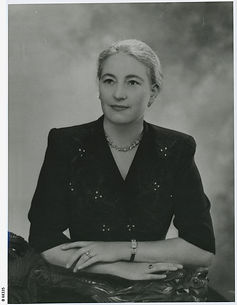
Read more:
Obituary: J A T Mortlock - Australian Dictionary of Biography:
Next pages: 4a Martindale House
4b MV Yacht Martindale
5 Historic interwar Martindale
6 University of Adelaide & Martindale Hall



